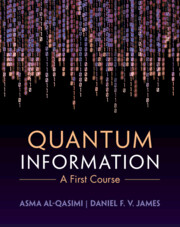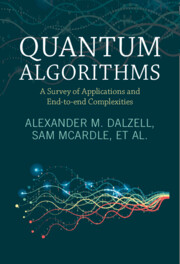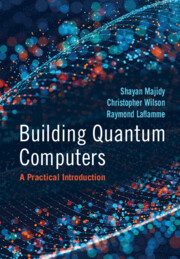Refine search
Actions for selected content:
41 results

Quantum Information
- A First Course
-
- Published online:
- 17 October 2025
- Print publication:
- 26 June 2025
-
- Textbook
- Export citation
Comparing gate and annealing-based quantum computing for configuration-based design tasks
-
- Journal:
- Design Science / Volume 11 / 2025
- Published online by Cambridge University Press:
- 14 October 2025, e40
-
- Article
-
- You have access
- Open access
- HTML
- Export citation
Quantum Computing in Finance: Regulatory Readiness, Legal Gaps, and the Future of Secure Tech Innovation
-
- Journal:
- European Journal of Risk Regulation , First View
- Published online by Cambridge University Press:
- 09 September 2025, pp. 1-32
-
- Article
-
- You have access
- Open access
- HTML
- Export citation
Opportunities and challenges of quantum computing for climate modeling
-
- Journal:
- Environmental Data Science / Volume 4 / 2025
- Published online by Cambridge University Press:
- 21 July 2025, e35
-
- Article
-
- You have access
- Open access
- HTML
- Export citation

Quantum Algorithms
- A Survey of Applications and End-to-end Complexities
-
- Published online:
- 03 May 2025
- Print publication:
- 24 April 2025
-
- Book
-
- You have access
- Open access
- Export citation
3 - Elements of Quantum Mechanics II: Open Systems
- from Part I - Preliminaries
-
- Book:
- Quantum Resource Theories
- Published online:
- 03 May 2025
- Print publication:
- 10 April 2025, pp 75-132
-
- Chapter
- Export citation
Quantum Computing and the Law: Navigating the Legal Implications of a Quantum Leap
-
- Journal:
- European Journal of Risk Regulation / Volume 16 / Issue 2 / June 2025
- Published online by Cambridge University Press:
- 13 February 2025, pp. 794-813
-
- Article
-
- You have access
- Open access
- HTML
- Export citation
Probing the production of quantum technologies to imagine its legal framework
-
- Journal:
- Research Directions: Quantum Technologies / Volume 3 / 2025
- Published online by Cambridge University Press:
- 08 January 2025, e1
-
- Article
-
- You have access
- Open access
- HTML
- Export citation
Quantum internal models for Solvency II and quantitative risk management
-
- Journal:
- British Actuarial Journal / Volume 30 / 2025
- Published online by Cambridge University Press:
- 06 January 2025, e1
-
- Article
-
- You have access
- Open access
- HTML
- Export citation
23 - Navigating in a Post-Quantum Legal Design Landscape
- from IV - Where Legal Design Goes
-
-
- Book:
- Legal Design
- Published online:
- 19 December 2024
- Print publication:
- 19 December 2024, pp 355-369
-
- Chapter
- Export citation

Building Quantum Computers
- A Practical Introduction
-
- Published online:
- 29 November 2024
- Print publication:
- 11 July 2024
-
- Textbook
- Export citation
A linear linear lambda-calculus
-
- Journal:
- Mathematical Structures in Computer Science / Volume 34 / Issue 10 / November 2024
- Published online by Cambridge University Press:
- 31 May 2024, pp. 1103-1137
-
- Article
- Export citation
8 - Quantum Mechanics and Technology
- from Part I - A Nonmathematical Exposition of Quantum Mechanics and Quantum Field Theory
-
- Book:
- Interpreting Quantum Mechanics
- Published online:
- 09 May 2024
- Print publication:
- 16 May 2024, pp 111-127
-
- Chapter
- Export citation
RF and microwave metrology for quantum computing – recent developments at the UK’s National Physical Laboratory
-
- Journal:
- International Journal of Microwave and Wireless Technologies / Volume 16 / Issue 4 / May 2024
- Published online by Cambridge University Press:
- 25 April 2024, pp. 535-543
-
- Article
-
- You have access
- Open access
- HTML
- Export citation
6 - Quantum Technology and Applications
-
- Book:
- A Computational Introduction to Quantum Physics
- Published online:
- 24 April 2024
- Print publication:
- 25 April 2024, pp 101-129
-
- Chapter
- Export citation
Developing a human rights compatible governance framework for quantum computing
-
- Journal:
- Research Directions: Quantum Technologies / Volume 2 / 2024
- Published online by Cambridge University Press:
- 08 March 2024, e1
-
- Article
-
- You have access
- Open access
- HTML
- Export citation
11 - Applications of Entanglement: Heisenberg-Limited Interferometry and Quantum Information Processing
-
- Book:
- Introductory Quantum Optics
- Published online:
- 14 December 2023
- Print publication:
- 30 November 2023, pp 338-385
-
- Chapter
- Export citation
Learning quantum finite automata with queries
-
- Journal:
- Mathematical Structures in Computer Science / Volume 34 / Issue 2 / February 2024
- Published online by Cambridge University Press:
- 30 November 2023, pp. 128-146
-
- Article
- Export citation
A concrete model for a typed linear algebraic lambda calculus
-
- Journal:
- Mathematical Structures in Computer Science / Volume 34 / Issue 1 / January 2024
- Published online by Cambridge University Press:
- 21 November 2023, pp. 1-44
-
- Article
- Export citation
Encoding the Enforcement of Safety Standards into Smart Robots to Harness Their Computing Sophistication and Collaborative Potential: A Legal Risk Assessment for European Union Policymakers
-
- Journal:
- European Journal of Risk Regulation / Volume 15 / Issue 3 / September 2024
- Published online by Cambridge University Press:
- 06 November 2023, pp. 665-704
-
- Article
-
- You have access
- Open access
- HTML
- Export citation




